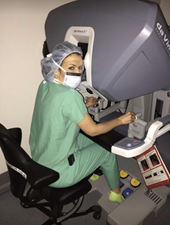 The National Center for Health Statistics reports that over five million people in the United States suffer from a hernia, but only about 15% of them seek medical help every year. Hernia is basically a hole and occurs when one of the organs bulges out through a weak spot in a muscle that normally keeps it in place.
The National Center for Health Statistics reports that over five million people in the United States suffer from a hernia, but only about 15% of them seek medical help every year. Hernia is basically a hole and occurs when one of the organs bulges out through a weak spot in a muscle that normally keeps it in place.
Minimally invasive surgery, especially robotics has grown in popularity recently, especially for hernia repairs. Benefits include fewer complications, smaller incisions, faster recovery time, and less pain. Vedra Augenstein, MD, an Atrium Health general surgeon, is a leading expert in the field of hernia surgery and robotic surgery. She recently answered some questions on the topic.
How long has robotic surgery been available?
Robotic surgery been around for a while. Predominantly it’s been used for urology but now it is used across almost all surgical specialties. “You see it in oncology, gynecology, thoracics, and lately with increased utilization in general surgery, especially pertaining to hernia repairs,” says Augenstein. “I’ve been performing robotic surgery since 2015 and see benefits across various types of surgical procedures. It is really expanding the use of minimally invasive surgery”
How does it work and why has it become more popular?
The surgeon completely controls the robotic arms while watching from a control panel with high-quality 3-D images which allow for utmost precision during dissection and reconstruction. Several tiny incisions, usually the size of a keyhole, are made in the abdomen. Small instruments guided by a camera are used to repair the hernia with mesh and stitches. With smaller incisions, there’s less risk of getting a wound infection as well as less pain. Patients also heal much quicker and they prefer the cosmesis of the smaller incisions.
What types of hernias can be treated robotically?
Hernias can develop in many various parts of the body, but the most common involve the abdominal area and can be differentiated as follows:
- Inguinal hernia– this is the most common type (about 70% of all cases); it appears in the groin area.
- Femoral hernia– occurs in the upper part of the thigh or groin.
- Hiatal hernia– it happens when the upper stomach protrudes through the diaphragm into the chest cavity.
- Umbilical hernia– appears near the navel; prematurely born babies are prone to have it.
- Incisional hernia– it may develop due to incompletely-healed wound after an abdominal surgery; it’s a bulge at the sight of the healing scar.
Why has robotic surgery increased for hernias?
Its use in repairing hernias has really picked up over the last few years. And since there are a lot of hernias out there – it’s one of the most common surgeries in general surgery currently being performed robotically. There’s been a huge percentage increase in robotic hernia repair and since first starting to use robotics in 2015 and I’ve been seen benefits and am using it more and more for hernia repair of all kinds, from groin hernias, to abdominal hernias and hernias in the diaphragm.
Is the robot performing the operation?
No, the robot doesn’t have any actual intelligence or automation meaning that it never does anything that my hands don’t do on the console. As I move my hands, the robot is operating.
Are there risks associated specifically with robotic surgery?
As with any surgery, there are some risks. The important thing to think about as a patient is to find the doctor you feel comfortable with and who has had experience in minimally invasive and robotic surgery. “As a surgeon, it is really important to understand how to appropriately use this tool to minimize complications for the patient and achieve optimal outcomes,” says Augenstein.
Is it beneficial for surgeons as well as patients?
“Yes,” says Augenstein. “Because we’re sitting down comfortably and we’re not fighting with the thickness and forces of the abdominal wall. With a robot, surgeons have the most optimal visualization and are able to control the camera themselves, says Augenstein. “You can see everything much better, you are comfortable during the procedure, unstrained and this all helps our performance.”
Robotic surgery is growing in popularity. Learn more about general surgery and Atrium Health’s Carolinas Hernia Institute here.



